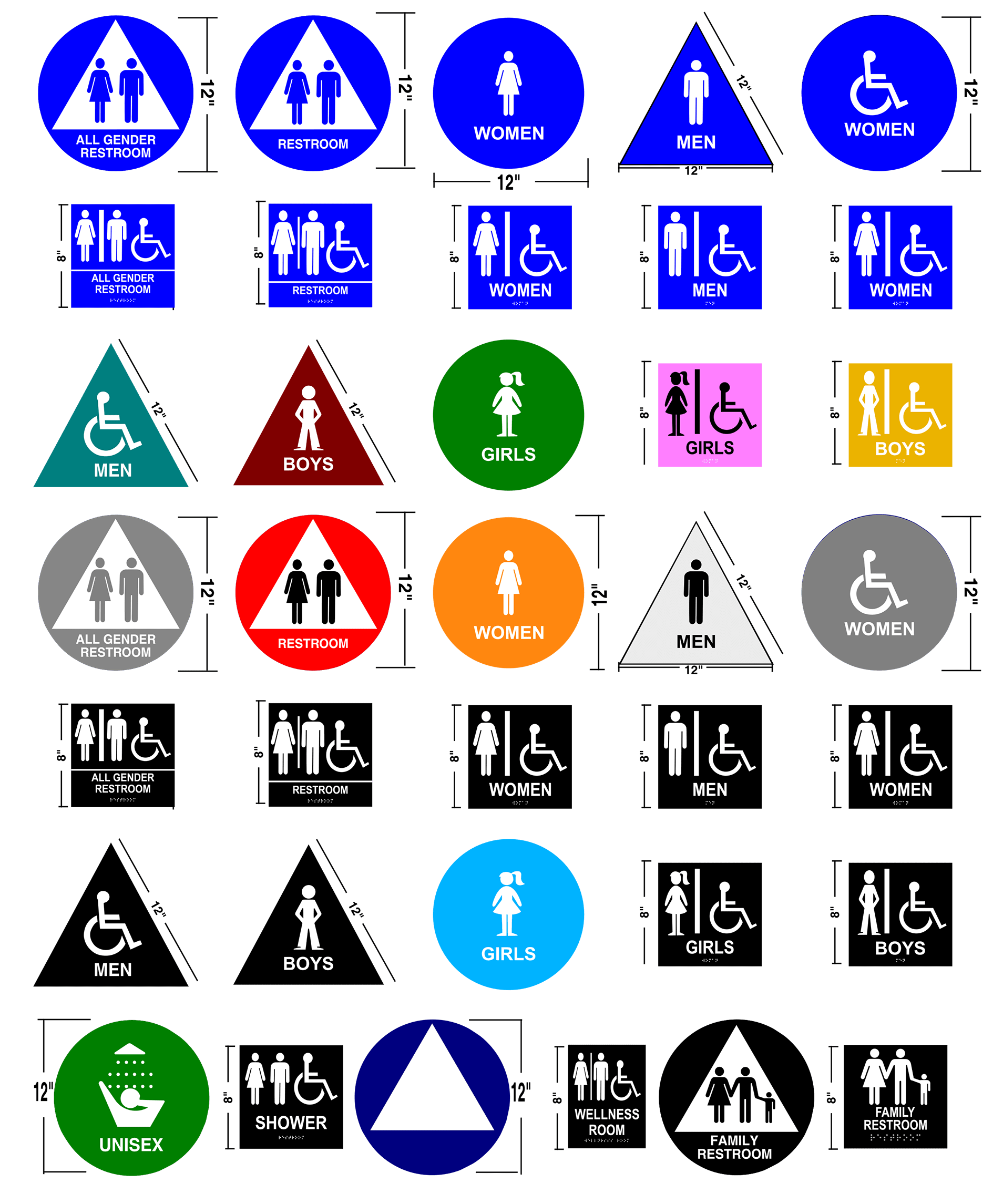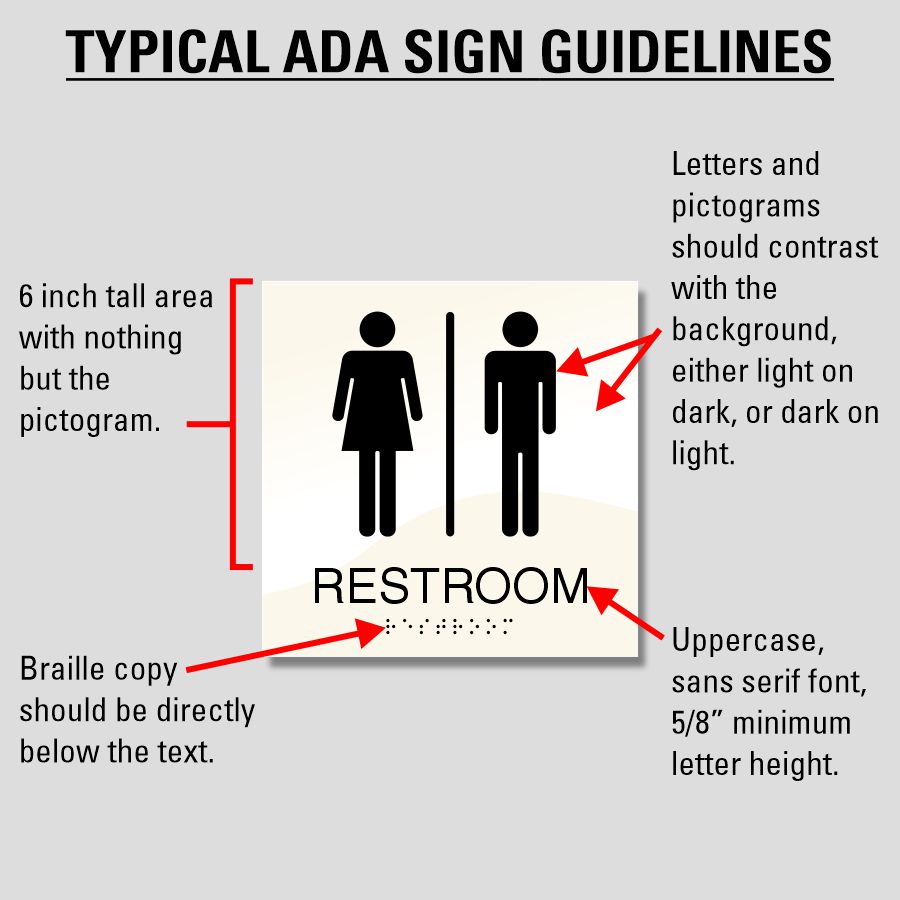A Comprehensive Overview to Picking the Right ADA Signs
A Comprehensive Overview to Picking the Right ADA Signs
Blog Article
Discovering the Secret Functions of ADA Indicators for Enhanced Access
In the world of availability, ADA indications offer as quiet yet powerful allies, guaranteeing that areas are comprehensive and accessible for individuals with handicaps. By integrating Braille and responsive aspects, these indicators damage obstacles for the visually damaged, while high-contrast shade systems and clear typefaces provide to varied aesthetic requirements.
Relevance of ADA Conformity
Ensuring compliance with the Americans with Disabilities Act (ADA) is vital for cultivating inclusivity and equivalent accessibility in public spaces and workplaces. The ADA, passed in 1990, mandates that all public facilities, employers, and transportation services accommodate people with disabilities, ensuring they appreciate the exact same rights and possibilities as others. Compliance with ADA requirements not only satisfies lawful commitments however additionally boosts an organization's track record by demonstrating its dedication to variety and inclusivity.
Among the key facets of ADA compliance is the execution of obtainable signs. ADA indications are designed to guarantee that individuals with disabilities can conveniently navigate with buildings and rooms. These indicators should stick to particular guidelines relating to size, typeface, color contrast, and placement to assure exposure and readability for all. Correctly implemented ADA signage helps eliminate barriers that people with impairments usually encounter, consequently advertising their self-reliance and self-confidence (ADA Signs).
Moreover, sticking to ADA policies can alleviate the danger of prospective fines and lawful effects. Organizations that fall short to conform with ADA standards may encounter lawsuits or charges, which can be both destructive and economically burdensome to their public photo. Hence, ADA conformity is essential to promoting an equitable environment for everybody.
Braille and Tactile Aspects
The unification of Braille and responsive components into ADA signs embodies the principles of access and inclusivity. These features are essential for individuals that are aesthetically impaired or blind, enabling them to navigate public areas with greater self-reliance and self-confidence. Braille, a responsive writing system, is crucial in providing written info in a format that can be conveniently viewed through touch. It is typically positioned below the corresponding message on signage to make certain that individuals can access the info without visual help.
Tactile components prolong beyond Braille and include raised icons and characters. These parts are designed to be discernible by touch, allowing people to identify area numbers, toilets, leaves, and various other essential locations. The ADA sets particular guidelines pertaining to the dimension, spacing, and positioning of these responsive aspects to enhance readability and make certain consistency throughout different atmospheres.

High-Contrast Color Design
High-contrast color pattern play a pivotal role in enhancing the presence and readability of ADA signs for individuals with visual problems. These schemes are vital as they optimize the difference in light reflectance in between message and helpful site background, ensuring that signs are easily discernible, also from a range. The Americans with Disabilities Act (ADA) mandates the usage of particular shade contrasts to fit those with limited vision, making it an essential aspect of conformity.
The efficiency of high-contrast colors lies in their capacity to stick out in various lighting problems, consisting of dimly lit atmospheres and areas with glare. Typically, dark text on a light history or light text on a dark background is employed to accomplish optimal contrast. Black text on a white or yellow background offers a stark visual difference that helps in quick recognition and comprehension.

Legible Fonts and Text Size
When taking into consideration the layout of ADA signs, the option of clear typefaces and proper message size can not be overstated. These components are essential for guaranteeing that indicators come to individuals with visual disabilities. The Americans with Disabilities Act (ADA) mandates that fonts should be not italic and sans-serif, oblique, manuscript, extremely ornamental, or of unusual form. These requirements assist ensure that the text is easily understandable from a range and that the characters are distinguishable to varied audiences.
The dimension of the text also plays a crucial function in accessibility. According to ADA standards, the minimal message height need to be 5/8 inch, and it must enhance proportionally with seeing range. This is specifically crucial in public areas where signage demands to be read swiftly and properly. Consistency in message dimension adds to a natural aesthetic experience, aiding people in navigating atmospheres efficiently.
In addition, spacing in between lines and letters is integral to legibility. Ample spacing avoids characters from appearing crowded, improving readability. By sticking to these standards, developers can considerably improve accessibility, ensuring that signs offers its desired objective for all individuals, despite their visual capacities.
Efficient Positioning Techniques
Strategic positioning of ADA signs is essential for taking full advantage of availability and making sure compliance with legal requirements. ADA guidelines stipulate that signs need to be mounted at a height between 48 to 60 inches from the ground to ensure they are within the line of view for both standing and seated see here now individuals.
In addition, indicators should be positioned surrounding to the lock side of doors to permit easy recognition before access. Uniformity in indicator placement throughout a center boosts predictability, minimizing confusion and improving general individual experience.

Conclusion
ADA indicators play a crucial duty in promoting access by integrating attributes that deal with the requirements of individuals with specials needs. These aspects collectively foster an inclusive atmosphere, emphasizing the importance of ADA conformity in ensuring equivalent accessibility for all.
In the realm of ease of access, ADA signs serve as quiet yet effective allies, guaranteeing that areas are inclusive and accessible for people with disabilities. The ADA, established in 1990, mandates that all public centers, employers, and transportation solutions suit people with impairments, guaranteeing they delight in the very same legal rights and possibilities as others. ADA Signs. ADA indications are made to make sure that people with handicaps can easily browse via spaces and buildings. ADA guidelines stipulate that signs must be placed at an elevation in between 48 to 60 inches from the ground to guarantee they are within the line of sight for both standing and seated individuals.ADA signs play a crucial duty in advertising access by incorporating features that deal with the demands of people with disabilities
Report this page